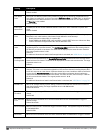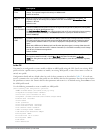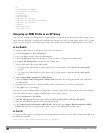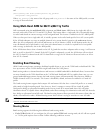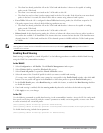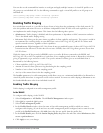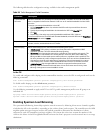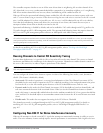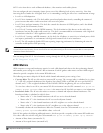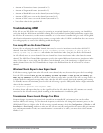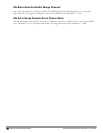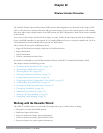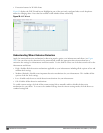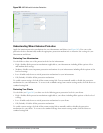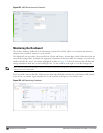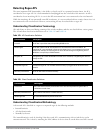
361 | AdaptiveRadioManagement (ARM) DellPowerConnectW-SeriesArubaOS6.2 | User Guide
802.11 noise from devices such as Bluetooth headsets, video monitors and cordless phones.
You can configure the noise immunity feature for any one of the following levels of noise sensitivity. Note that
increasing the level makes the AP slightly “deaf” to its surroundings, causing the AP to lose a small amount of range.
l Level 0: no ANI adaptation.
l Level 1: Noise immunity only. This level enables power-based packet detection by controlling the amount of
power increase that makes a radio aware that it has received a packet.
l Level 2: Noise and spur immunity. This level also controls the detection of OFDM packets, and is the default
setting for the Noise Immunity feature.
l Level 3: Level 2 settings and weak OFDM immunity. This level minimizes false detects on the radio due to
interference, but may also reduce radio sensitivity. This level is recommended for environments with a high-level
of interference related to 2.4Ghz appliances such as cordless phones.
l Level 4: Level 3 settings, and FIR immunity. At this level, the AP adjusts its sensitivity to in-band power, which
can improve performance in environments with high and constant levels of noise interference.
l Level 5: The AP completely disables PHY error reporting, improving performance by eliminating the time the
controller would spend on PHY processing.
NOTE: Only 802.11n-capable APs simultaneously support both the RX Sensitivity Tuning Based Channel Reuse feature and a level-3
to level-5 Noise Immunity setting. Do not raise the noise immunity default setting on APs that do not support 802.11n unless you first
disable the Channel Reuse feature.
You can manage Non-802.11 Noise Immunity settings through the 802.11g RF management profile. For details refer
to “RF Management” on page433.
ARM Metrics
ARM computes coverage and interference metrics for each valid channel and chooses the best performing channel
and transmit power settings for each AP’s RF environment. Each AP gathers other metrics on their ARM-assigned
channel to provide a snapshot of the current RF health state.
The following two metrics help the AP decide which channel and transmit power setting is best.
l Coverage Index: The AP uses this metric to measure RF coverage. The coverage index is calculated as x/y, where
“x” is the AP’s weighted calculation of the Signal-to-Noise Ratio (SNR) on all valid APs on a specified 802.11
channel, and “y” is the weighted calculation of the Dell AP's SNR the neighboring APs see on that channel.
To view these values for an AP in your current WLAN environment issue the CLI command show ap arm rf-
summary ap-name <ap-name>, where <ap-name> is the name of an AP for which you want to view information.
l Interference Index: The AP uses this metric to measure co-channel and adjacent channel interference. The
Interference Index is calculated as a/b//c/d, where:
l Metric value “a” is the channel interference the AP sees on its selected channel.
l Metric value “b” is the interference the AP sees on the adjacent channel.
l Metric value “c” is the channel interference the AP’s neighbors see on the selected channel.
l Metric value “d” is the interference the AP’s neighbors see on the adjacent channel
To manually calculate the total Interference Index for a channel, issue the CLI command show ap arm rf-
summary ap-name <ap-name>, then add the values
a+b+c+d.
Each AP also gathers the following additional metrics, which can provide a snapshot of the current RF health state.
View these values for each AP using the CLI command show ap arm rf-summary ip-addr <ap ip address>.
l Amount of Retry frames (measured in %)
l Amount of Low-speed frames (measured in %)



